< Previous | Contents | Next >
In Belvoir Vale
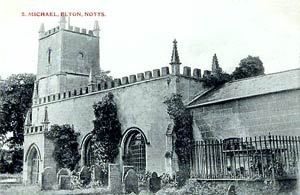
Elton church, c.1910.
ELTON. It is part of the lovely Vale of Belvoir, and peeps into the top corner of Leicestershire. All it has to show comes into a glance, its charming stretch of road between Bingham and Grantham, the inn, a row of white-walled dwellings, and a tiny church in a churchyard with a yew hedge trimmed like a battlement. Its old companion, the big house built by the famous Adam brothers, has been pulled down.
The church is only 15 feet wide, and has little claim to beauty. Three round arches built up in a wall, coming perhaps from the close of Norman days, tell of a vanished aisle, and in the modern porch is a 14th century doorway which was set back when the aisle was destroyed. The plain font may be 700 years old.
The heavy altar rails are Jacobean, and worked up into the high pews are parts of the medieval chancel screen. Two modern oak choir seats are interesting for their carvings of four heads above the names of Knox, Latimer, Cranmer, and Edward the Sixth, who is shown as a young king in cap and ruff. The oak pulpit is ornate with scrollwork panels, and the east window has Paul preaching on Mars Hill.
Jeremiah Carfinter's Half-Century
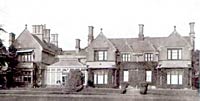
Epperstone Manor, c.1910.
EPPERSTONE. A rare natural charm has this small village enshrined in trees, with old houses, an ancient dovecot, and the Dover Beck meandering through the willows. Opposite the church the manor house comes to the road, and through its beautiful gateway we see a fine drive of trimmed trees. From the path crossing the park to Woodborough we see the front of the house and its charming garden.
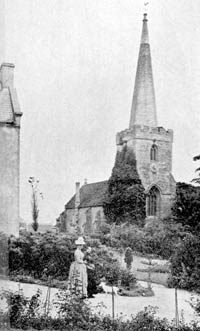
Epperstone church, c.1900.
The church stands high above the road, a flight of steps climbing to the churchyard, where one of the fine trees is a magnificent cedar with propped-up branches sheltering a patch of ground about 90 yards round. Here, too, a shaded walk leads to the cottages beyond, and gives us a peep of the Old Manor below. There is a stone in the churchyard to Jeremiah Carfinter, who was over half a century at the rectory and died in 1840.
Among many corbel heads outside is a woman in a wimple, a head which has lost its features but has kept a crown, and a little fellow who has been looking across the churchyard for centuries. Crude gargoyles look down from the handsome 15th century tower whose spire has a 19th century top, and a king and a queen greet us as we reach the modern porch. A door with beautiful old timber inside opens to the dim interior, where the two finest things are the splendid tower arch, reaching to the roof, and the graceful 13th century nave arcade, with clustered pillars and unusual capitals. In the foliage of one capital is a fine head.
All that remains of the 14th century chancel is the east window. The font has a massive Norman bowl, and there may be some Norman masonry in the north wall. One of several coffin stones is a fine specimen carved 700 years ago. Two oak angels with wings look down from the chancel, and the oak pulpit has old panels with quaint figures said to have been carved by a sexton.
An inscription tells of John Odingsells who was member for Nottingham in the Barebones Parliament. The stone figure of a man with praying hands, wearing a long gown, may be one of this family, who knew the village for many generations.
The Two Dragons
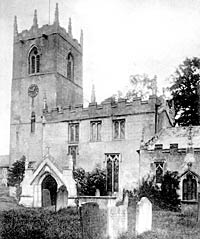
Everton church, c.1908.
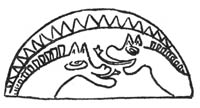
Tympanum.
EVERTON. Pleasant with its red roofs and winding ways, it lies in the valley of the River Idle, and looks across miles of reclaimed fenland which stretch as far as Yorkshire. It has an old windmill which has lost its sails, a wayside cross to men who died for peace, and a small church of which it can well be proud, for it has Norman remains and one treasure older still—an ancient tympanum belonging perhaps to Saxon days, crudely engraved with the heads of two dragons facing each other with tongues outstretched. It is over the doorway through which we enter.
The lovely chancel arch and the fine little horseshoe arch to the tower are Norman. Both are adorned with zigzag and thrown into relief by the dim backgrounds of a 19th century apse and the old tower. Except for its arch and a Norman window, the tower is chiefly 15th century. The Norman arch frames a splendid tub font carved with arcading.and bands of zigzag and cable. It is a 19th century copy of the original Norman font, of which a battered part is now in the church after a sojourn in the vicarage garden. A fine little arcade of about 1190 divides the nave and aisle, and a capital carved with foliage crowns the pillar between the two bays. From the 15th century come the clerestory and the windows of the nave and aisle.
There are four old armchairs, and a huge and rather battered stone has the worn portraits of a 13th century knight and his lady.
